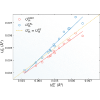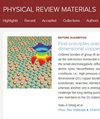量化难熔高熵合金中的局部晶格畸变
IF 3.4
3区 材料科学
Q2 MATERIALS SCIENCE, MULTIDISCIPLINARY
引用次数: 0
摘要
严重的局部晶格畸变(LLDs)源于原子之间的尺寸不匹配,已被认为是导致 bcc 结构高熵合金(HEAs)具有优异机械性能的关键机制之一。它们还与相稳定性以及导电性等物理性质有关。然而,LLD 的实验测量十分困难,而且往往模棱两可。有人提出分析真实空间中的全散射数据可为 LLDs 提供独一无二的合适探针,但其广泛应用和验证仍然有限。我们利用小盒子对分布函数 (PDF) 分析对难熔高熵合金 (RHEA) 中的 LLD 测量进行了深入研究。我们首先利用最近提出的连贯理论框架重新审查了现有的文献数据,证明 RHEA 中的 LLD 确实可以被认为是严重的,即使在没有已知热成分的情况下也能可靠地测量。我们使用 X 射线和中子对典型的 RHEA(HfNbTaTiZr)进行了全散射实验,结果表明,对来自不同类型辐射的数据进行实空间 PDF 分析可得出一致的 LLD 值。这些结果与根据倒易空间数据得出的值也非常一致。最后,通过对理论两相 PDF 的模拟和分析,我们证明在处理相对较大的 LLD 时,所研究的 RHEA 中的化学偏析对测量 LLD 的影响是有限的。结果表明,利用小盒子建模进行 PDF 分析为测量 RHEA 中的 LLD 提供了一种快速可靠的工具,因此非常适合分析时间分辨原位测量的大型数据集。本文章由计算机程序翻译,如有差异,请以英文原文为准。

Quantifying local lattice distortions in refractory high-entropy alloys
Severe local lattice distortions (LLDs), originating from the size mismatch among atoms, have been proposed as one of the key mechanisms responsible for the excellent mechanical properties of bcc-structured high-entropy alloys (HEAs). They have also been connected to phase stability, as well as physical properties such as electrical conductivity. Experimental measurements of LLDs are, however, difficult and often ambiguous. Analysis of total scattering data in real space has been proposed to provide a uniquely suitable probe of LLDs, but its widespread application and validation are still limited. We conduct a thorough study of LLD measurements in refractory high-entropy alloys (RHEAs) using small-box pair distribution function (PDF) analysis. We start by reexamining existing literature data using a recently proposed coherent theoretical framework to demonstrate that LLDs in RHEAs can indeed be considered as severe and can be reliably measured even in the absence of known thermal components. We perform total scattering experiments of a typical RHEA (HfNbTaTiZr) using both x-rays and neutrons, and show that real-space PDF analysis of data from different types of radiation gives consistent values of LLDs. The results are also in good agreement with the values derived from reciprocal-space data. Finally, through simulation and analysis of theoretical two-phase PDFs, we demonstrate that the effect of the chemical segregation in the investigated RHEA on the measured LLDs is limited when dealing with comparatively large LLDs. The results show that PDF analysis using small-box modeling provides a fast and reliable tool for measuring LLDs in RHEAs, which makes it ideal for analysis of large data sets from time-resolved in situ measurements.
求助全文
通过发布文献求助,成功后即可免费获取论文全文。
去求助
来源期刊

Physical Review Materials
Physics and Astronomy-Physics and Astronomy (miscellaneous)
CiteScore
5.80
自引率
5.90%
发文量
611
期刊介绍:
Physical Review Materials is a new broad-scope international journal for the multidisciplinary community engaged in research on materials. It is intended to fill a gap in the family of existing Physical Review journals that publish materials research. This field has grown rapidly in recent years and is increasingly being carried out in a way that transcends conventional subject boundaries. The journal was created to provide a common publication and reference source to the expanding community of physicists, materials scientists, chemists, engineers, and researchers in related disciplines that carry out high-quality original research in materials. It will share the same commitment to the high quality expected of all APS publications.
 求助内容:
求助内容: 应助结果提醒方式:
应助结果提醒方式:


